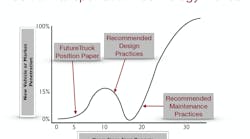I was changing planes in Dallas Ft. Worth airport a couple of weeks ago. I rode their Skylink transit vehicle. For all intents and purposes, it was an autonomous vehicle. No driver in site. No steering wheel. No brake pedals. Of course, I expect there was quite a bit of monitoring in a control room somewhere on the premises, in case something went wrong.
When I went to my hotel, I rode the elevator to the 15th floor. Again, not a driver in site. Just push a button and it operates autonomously, getting me where I want to go, complete with freight (my luggage).
Now, several organizations want to apply some of the same technology to commercial vehicles hauling people and freight. The countdown has begun to autonomous commercial vehicles—the race, if you want to call it that, is on.
1. Otto is in a legal dispute with Alphabet (Google). Their sister company, Uber, suspended autonomous driving of its vehicles for a few days this month after an accident, reportedly caused by the other vehicle.
2. Tesla is known to be hiring people for a truck. It will certainly be electric, but given what they do with autonomous operation on the cars, it will likely have some level of self-operation—might it be much more fashionable looking than a current truck?
3. Embark (formerly Varden Labs) came out of stealth mode in late February. Of course, they weren’t in stealth mode for long. They were Canadian college students just last year when they showed off Marvin, their small golf cart.
4. Starsky Robotics is looking to make a retrofit kit to make an existing truck run autonomously.
5. Daimler showed an autonomous truck last year, but seems pretty quiet about taking it any further at this time.
6. PACCAR just announced a deal with Nvidia on self-driving truck technology.
7. Volvo and others in the mining industry have had autonomous vehicles in actual operation for more than 4 years now.
While the above are working on autonomy, Nikola says they will have a hydrogen powered electric truck out by mid-2020 with on-road testing starting next year. Some 4,000 reservations have been taken for the vehicle, an approach that Tesla used to get money up front and similar to what others do with crowdfunding sources such as KickStarter. But, even since December, they’ve made some significant changes as they learn more about this industry. No longer will they provide a 6x6 drive configuration. I wonder what else they will learn about what it takes to put out a new vehicle from scratch.
In my experience in the trucking industry, it takes on the order of 30 years to go from prototypes to high volume. I use the Automated Mechanical Transmission as an example. I was working on them in 1985 at Eaton. Today, more than 50% of Class 8 trucks are going out the manufacturing assembly door with them. Other examples are anti-lock brakes and collision mitigation systems. At TMC I presented this chart. It’s based on the Gartner Hype Cycle and the standard charts used for take up of technology in an industry. We are just at the beginning now and developing guidelines for the future. We will see prototypes out in small quantities in the next few years, but not large volumes.
So, my belief is we will see autonomous vehicles, trucks, shuttles, mining vehicles, taxis, and trucks. We will not see Auto NoMo for Us, but we will see autonomous vehicles. Just look for the blue light special as it approaches you.




